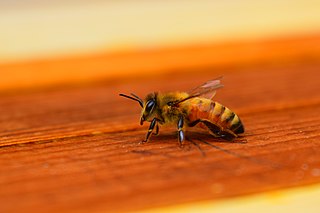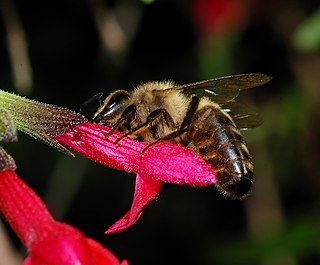
A honey bee is a eusocial flying insect within the genus Apis of the bee clade, all native to mainland Afro-Eurasia. After bees spread naturally throughout Africa and Eurasia, humans became responsible for the current cosmopolitan distribution of honey bees, introducing multiple subspecies into South America, North America, and Australia.

Mites are small arachnids. Mites span two large orders of arachnids, the Acariformes and the Parasitiformes, which were historically grouped together in the subclass Acari. However, most recent genetic analyses do not recover the two as each other's closest relative within Arachnida, rendering the group non-monophyletic. Most mites are tiny, less than 1 mm (0.04 in) in length, and have a simple, unsegmented body plan. The small size of most species makes them easily overlooked; some species live in water, many live in soil as decomposers, others live on plants, sometimes creating galls, while others are predators or parasites. This last type includes the commercially destructive Varroa parasite of honey bees, as well as scabies mites of humans. Most species are harmless to humans, but a few are associated with allergies or may transmit diseases.
Delusional parasitosis (DP) is a mental disorder in which individuals have a persistent belief that they are infested with living or nonliving pathogens such as parasites, insects, or bugs, when no such infestation is present. They usually report tactile hallucinations known as formication, a sensation resembling insects crawling on or under the skin. Morgellons is considered to be a subtype of this condition, in which individuals have sores that they believe contain harmful fibers.

The Apis mellifera mellifera is a subspecies of the western honey bee, evolving in central Asia, with a proposed origin of the Tien Shan Mountains and later migrating into eastern and then northern Europe after the last ice age from 9,000BC onwards. Its original range included the southern Urals in Russia and stretched through northern Europe and down to the Pyrenees. They are one of the two members of the 'M' lineage of Apis mellifera, the other being in western China. Traditionally they were called the Black German Bee, although they are now considered endangered in Germany. However today they are more likely to be called after the geographic / political region in which they live such as the British Black Bee, the Native Irish Honey Bee, the Cornish Black Bee and the Nordic Brown Bee, even though they are all the same subspecies, with the word "native" often inserted by local beekeepers, even in places where the bee is an introduced foreign species. It was domesticated in Europe and hives were brought to North America in the colonial era in 1622 where they were referred to as the English Fly by the Native Americans.

Varroa destructor, the Varroa mite, is an external parasitic mite that attacks and feeds on honey bees and is one of the most damaging honey bee pests in the world. A significant mite infestation leads to the death of a honey bee colony, usually in the late autumn through early spring. Without management for Varroa mite, honey bee colonies typically collapse within 2 to 3 years in temperate climates. These mites can infest Apis mellifera, the western honey bee, and Apis cerana, the Asian honey bee. Due to very similar physical characteristics, this species was thought to be the closely related Varroa jacobsoni prior to 2000, but they were found to be two separate species after DNA analysis.

The Russian honeybee refers to honey bees that originate in the Primorsky Krai region of Russia. This strain of bee was imported into the United States in 1997 by the USDA Agricultural Research Service's Honeybee Breeding, Genetics & Physiology Laboratory in Baton Rouge, Louisiana, in response to severe declines in bee populations caused by infestations of parasitic mites, and has been used in breeding programs to improve existing stocks. Many Russian queens openly mate with drones from various stock, creating colonies that are genetically hybrid. Some of these 'uncontrolled' hybrids may exhibit "increased aggressiveness, reduced honey production and a decrease in their ability to withstand mites and detrimental expressions of other traits as well."

Varroa is a genus of parasitic mesostigmatan mites associated with honey bees, placed in its own family, Varroidae. The genus was named for Marcus Terentius Varro, a Roman scholar and beekeeper. The condition of a honeybee colony being infested with Varroa mites is called varroosis.

Aethina tumida,commonly known as small hive beetle (SHB), is a beekeeping pest. It is native to sub-Saharan Africa, but has spread to many other regions, including North America, Australia, and the Philippines.

Karl Kehrle OSB OBE, known as Brother Adam, was a Benedictine monk, beekeeper, and an authority on bee breeding, developer of the Buckfast bee.
"He was unsurpassed as a breeder of bees. He talked to them, he stroked them. He brought to the hives a calmness that, according to those who saw him at work, the sensitive bees responded to." – The Economist, 14 September 1996
The Bureau of Entomology was a unit within the Federal government of the United States from 1894 to 1934. It developed from a section of the Department of Agriculture which had been working on entomological researches and allied issues relating to insects. In 1934 it was merged with the Bureau of Plant Quarantine to form the Bureau of Entomology and Plant Quarantine. A later merger with the Bureau of Animal Industry created the Agricultural Research Service in 1953.

Fluvalinate is a synthetic pyrethroid chemical compound contained as an active agent in the products Apistan, Klartan, and Minadox, that is an acaricide, commonly used to control Varroa mites in honey bee colonies, infestations that constitute a significant disease of such insects.
A grooming dance, grooming invitation dance or shaking dance is a dance performed by honeybees to initiate allogrooming. It was first reported in 1945 by biologist Mykola H. Hadak. An increase in the frequency of the grooming dance has been observed among the bees of mite-infested colonies, and among bees who have been dusted with small particles of chalk dust.

Commercial Beekeeping in the United States dates back to the 1860s.

Colony collapse disorder (CCD) is an abnormal phenomenon that occurs when the majority of worker bees in a honey bee colony disappear, leaving behind a queen, plenty of food, and a few nurse bees to care for the remaining immature bees. While such disappearances have occurred sporadically throughout the history of apiculture, and have been known by various names, the syndrome was renamed colony collapse disorder in early 2007 in conjunction with a drastic rise in reports of disappearances of western honey bee colonies in North America. Beekeepers in most European countries had observed a similar phenomenon since 1998, especially in Southern and Western Europe; the Northern Ireland Assembly received reports of a decline greater than 50%. The phenomenon became more global when it affected some Asian and African countries as well. From 1990 to 2021, the United Nation’s FAO calculated that the worldwide number of honeybee colonies increased 47%, reaching 102 million.
Robert "Bert" Orlando Beater Manley was a British farmer and beekeeper, an authority on commercial honey farming and developer of the popular Manley moveable frame hives and frame systems.
Varroa sensitive hygiene (VSH) is a behavioral trait of honey bees (Apis mellifera) in which bees detect and remove bee pupae that are infested by the parasitic mite Varroa destructor. V. destructor is considered to be the most dangerous pest problem for honey bees worldwide. VSH activity results in significant resistance to the mites.
Beekeeping is first recorded in Ireland in the seventh century. It has seen a surge in popularity in modern times, with the membership of beekeeping associations exceeding 4,500. The median average number of hives per beekeeper is three hives, while the average honey output per hive is 11.4 kg. The growth in the practice has occurred despite increased pressures on bees and beekeepers due to parasites, diseases and habitat loss.
Jeffery Stuart Pettis is an American-born biologist and entomologist known for his extensive research on honeybee behavior. He is currently head of Apimondia. He was the research leader at the United States Department of Agriculture's Beltsville Bee Laboratory (BBL). His research has led to significant breakthroughs in understanding and managing CCD, a primary cause of North American bee population decline. He is also known for discovering with Dennis vanEngelsdorp, then at Pennsylvania State University, the ability of bees to detect pesticides and harmful fungi in collected pollen and subsequently quarantine the harmful substances from the rest of the hive. His research has also studied the synergistic effects of Imidacloprid on bees, an insecticide derived from nicotine which has been shown to contribute to CCD.

Chronic bee paralysis virus (CBPV) commonly affects adult Apis mellifera honey bees and causes a chronic paralysis that can easily spread to other members of a colony. Bees infected with CBPV begin to show symptoms after 5 days and die a few days after. Chronic bee paralysis virus infection is a factor that can contribute to or cause the sudden collapse of honeybee colonies. Since honeybees serve a vital role in ecological resilience, it is important to understand factors and diseases that threaten them.











